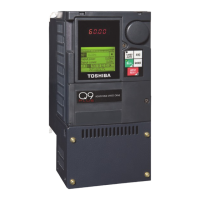24 https://www.toshiba.com/tic/
Electronic Operator Interface
Q9 Plus ASD Install/Op Manual
Using the LCD Screen
The LCD screen is the primary user input/output
information center. Parameter settings may be
viewed or changed using the LCD display unit of
the EOI. To view or change a parameter setting
using the LCD screen, press the Mode key until the
Program menu is displayed. Turn the Rotary
Encoder until the desired Primary Menu item (see
pg. 40) is within the cursor block. Press the Rotary
Encoder to select the item from the Primary Menu
(repeat for submenu items).
See the section titled Default Setting Changes on
pg. 29 for more information on changing parameter
settings.
Upon reaching the desired parameter selection, the
current setting may be viewed, or selected and
changed by pressing the Rotary Encoder and the
setting will take on the reverse video format (dark
background/light text). Turn the Rotary Encoder to
change the parameter setting. Press the ESC key
while the new parameter setting is in the reverse
video mode to exit the selection without saving the
change or press the Rotary Encoder while the
parameter setting is in the reverse video mode to
accept the change.
Repeated ESC key entries at any time takes the
menu back one level each time the ESC key is
pressed until the Frequency Command screen is
reached. Further ESC entries will toggle the system
to and from the Frequency Command screen and
the EOI Command menu.
Note: Changes carried out from the EOI Command
screen will be effective for EOI-controlled
ASD operation only. See the section titled
EOI Command Mode on pg. 36 for further
information on EOI Command Mode
operations.
Primary Menus of the LCD Screen
The three primary screens of the LCD screen are
displayed while accessing the associated operating
mode: the Frequency Command, Monitor, and the
Program Menu screens.
Speed Reference %
Speed Reference Hz
Not-Ready-to-Run
Indicator (ST-to-CC required)
Ready-to-Run Indicator
(appears when ST is connected
to CC)
Forward Run Active
Reverse Run Active
Discrete I/O Terminal Status or
Active Alarm Condition
Figure 22. Frequency Command Screen.
User-Selected
Monitored Parameters
(see
Main Monitor on pg. 48)
Item Number 1 of 43
Speed at Trip (if applicable)
Active DC Bus Voltage
Monitored Items
Command
Active Output Current
ASD Output Voltage
Screen Name
(only 5 items listed)
Active Frequency
Figure 23. Monitor Screen (see pg. 38 for more on the Monitor Screen).
Primary Menu Items
Screen Name
Item Number 1 of 15
Program Menu Items
{
(only 5 items listed)
Figure 24. Program Menu Screen (see pg. 40 for more on the Program Menu Screen).

